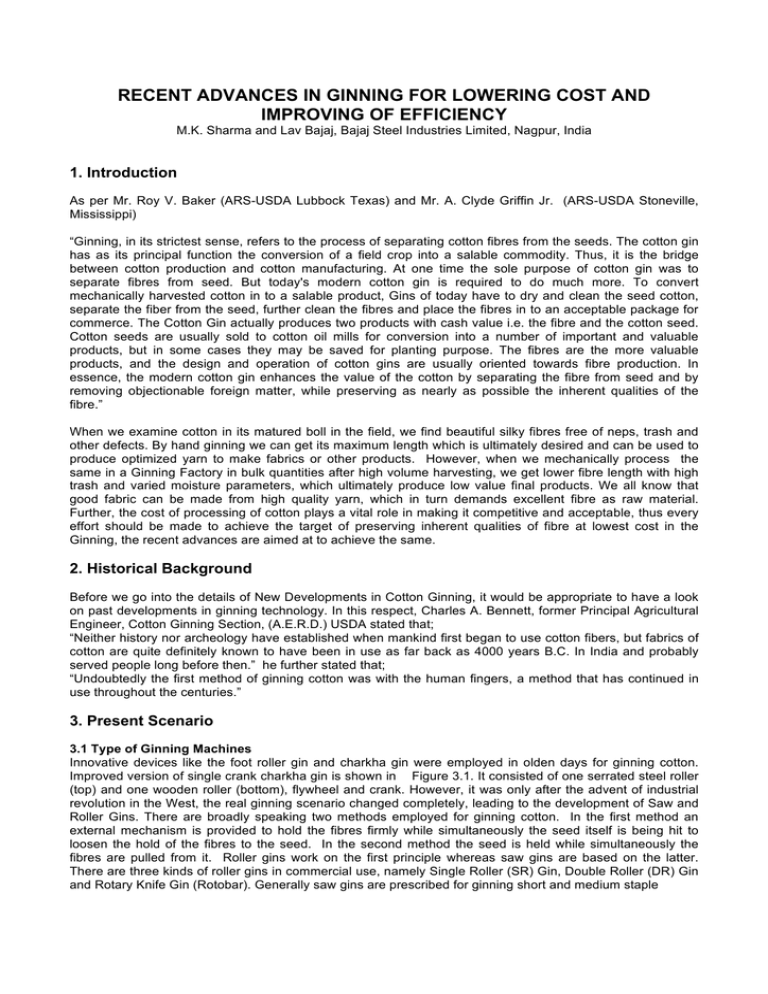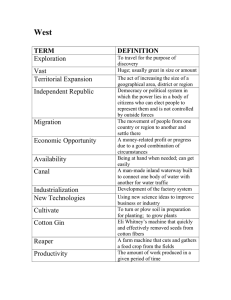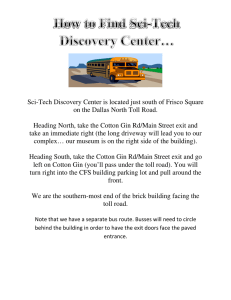Paper - ICAC
advertisement

RECENT ADVANCES IN GINNING FOR LOWERING COST AND IMPROVING OF EFFICIENCY M.K. Sharma and Lav Bajaj, Bajaj Steel Industries Limited, Nagpur, India 1. Introduction As per Mr. Roy V. Baker (ARS-USDA Lubbock Texas) and Mr. A. Clyde Griffin Jr. (ARS-USDA Stoneville, Mississippi) “Ginning, in its strictest sense, refers to the process of separating cotton fibres from the seeds. The cotton gin has as its principal function the conversion of a field crop into a salable commodity. Thus, it is the bridge between cotton production and cotton manufacturing. At one time the sole purpose of cotton gin was to separate fibres from seed. But today's modern cotton gin is required to do much more. To convert mechanically harvested cotton in to a salable product, Gins of today have to dry and clean the seed cotton, separate the fiber from the seed, further clean the fibres and place the fibres in to an acceptable package for commerce. The Cotton Gin actually produces two products with cash value i.e. the fibre and the cotton seed. Cotton seeds are usually sold to cotton oil mills for conversion into a number of important and valuable products, but in some cases they may be saved for planting purpose. The fibres are the more valuable products, and the design and operation of cotton gins are usually oriented towards fibre production. In essence, the modern cotton gin enhances the value of the cotton by separating the fibre from seed and by removing objectionable foreign matter, while preserving as nearly as possible the inherent qualities of the fibre.” When we examine cotton in its matured boll in the field, we find beautiful silky fibres free of neps, trash and other defects. By hand ginning we can get its maximum length which is ultimately desired and can be used to produce optimized yarn to make fabrics or other products. However, when we mechanically process the same in a Ginning Factory in bulk quantities after high volume harvesting, we get lower fibre length with high trash and varied moisture parameters, which ultimately produce low value final products. We all know that good fabric can be made from high quality yarn, which in turn demands excellent fibre as raw material. Further, the cost of processing of cotton plays a vital role in making it competitive and acceptable, thus every effort should be made to achieve the target of preserving inherent qualities of fibre at lowest cost in the Ginning, the recent advances are aimed at to achieve the same. 2. Historical Background Before we go into the details of New Developments in Cotton Ginning, it would be appropriate to have a look on past developments in ginning technology. In this respect, Charles A. Bennett, former Principal Agricultural Engineer, Cotton Ginning Section, (A.E.R.D.) USDA stated that; “Neither history nor archeology have established when mankind first began to use cotton fibers, but fabrics of cotton are quite definitely known to have been in use as far back as 4000 years B.C. In India and probably served people long before then.” he further stated that; “Undoubtedly the first method of ginning cotton was with the human fingers, a method that has continued in use throughout the centuries.” 3. Present Scenario 3.1 Type of Ginning Machines Innovative devices like the foot roller gin and charkha gin were employed in olden days for ginning cotton. Improved version of single crank charkha gin is shown in Figure 3.1. It consisted of one serrated steel roller (top) and one wooden roller (bottom), flywheel and crank. However, it was only after the advent of industrial revolution in the West, the real ginning scenario changed completely, leading to the development of Saw and Roller Gins. There are broadly speaking two methods employed for ginning cotton. In the first method an external mechanism is provided to hold the fibres firmly while simultaneously the seed itself is being hit to loosen the hold of the fibres to the seed. In the second method the seed is held while simultaneously the fibres are pulled from it. Roller gins work on the first principle whereas saw gins are based on the latter. There are three kinds of roller gins in commercial use, namely Single Roller (SR) Gin, Double Roller (DR) Gin and Rotary Knife Gin (Rotobar). Generally saw gins are prescribed for ginning short and medium staple cottons having length up to 27-28 mm. The single roller gins and double roller gins can be used for cottons of all staple categories while Rotobar gin is used for long and extra long cottons particularly black seeds only. Among all the types of roller gins, double roller gins are most commonly used in India and other countries due to its advantages over other ginning technologies. The ginning operation needs to be carried out carefully so that the fibres are not damaged or broken during the process and the overall quality of lint remains practically unchanged. For ensuring this, machinery used for the ginning process requires proper adjustments and regular maintenance. The details of each ginning machine is elaborated below: Figure 3.1 Improved version of charkha gin 3.2 Saw Gins The Saw Gin belongs to second-generation tool invented by Eli Whitney in 1794, in the USA and the latest version is shown in Figure 3.2. It consists of a series of circular saws, 305 to 407 mm (12 to 18 inches) in diameter. All the saws are mounted closely on an axle and are made to revolve at high speed in order to tear the lint away from a roll of seed cotton. The saw projects slightly between bars or ribs, which are so, spaced that they prevent the seed from going forward. Fibres are thus torn away from the seeds with high speed. The seed cotton is fed continuously into a rounded box or hopper. The action of the saws keeps it revolving in a loosely compacted roll. The seed falls through a grid into a collecting box or seed conveyor. The lint is whipped off the teeth of the saws by high-speed brushes or an air blast. Figure 3.2 Saw Gin stands in ginnery in USA The average saw gin turns out about 500 kg of lint per hour. However, saw gin gives about 1% to 3.5% less ginning percentage than single and double roller gin. Although the ginning output of saw gin is very high, these gins are not suitable for ginning extra-long staple (ELS) varieties and the lint is more nappy than the roller ginned lint. The maintenance of saw gin is very costly because there are many moving parts which are of special construction and many times are not readily available. Further, a qualified and experienced technician is required to operate saw gin stand to get the optimum output and to replace the worn out parts and adjust the gin for uniform processing of seed cotton. In view of limitations in respect of ginning short and medium staple cotton only, fibre length cutting and higher neps, saw gin in the countries like India where different varieties of different fibre parameters are grown has been phased out completely by double roller gins. The roller gins are classified as oscillatory knife gin and rotary knife gin depending upon the type of motion of moving knife. Oscillatory type gins are further classified as single roller (SR) and Double roller (DR) depending on the number of rollers used per machine while Rotary Knife gin is called Rotobar. 3.3.1 Single roller gin - McCarthy gin The principle of working of single roller gin is popularly known as McCarthy principle named after its proponent and shown in Figure3.3. Figure 3.3.1 Single Roller Gin It lies in picking and then moving the cotton fibres between the roller and fixed knife preventing the seeds to pass through. The seed cotton, when thrown into the hopper, passes through the machine. While the machine is working, at each elevation of the moving knife the grids lift the cotton to the level of the stationary knife-edge and of the exposed surface of the rollers. The free ends of the fibres are gripped, in the grooves of the rotating roller, and dragged forward till the seeds reach the edge of stationary knife. The edge where the fibre is caught is the ginning point. By the downward motion of the moving knife, the seeds are detached from the cotton at the ginning point and are thrown out through the slots of the grid. It is important that the grooves of the rollers should be kept well open and when the leather roller becomes smooth, rough file should be applied occasionally to the surface to keep the same grip and pull on the fibre. The seeds are then hammered by means of the rapidly moving knife whereby some fibres are separated. In subsequent cycles, the remaining fibres also get separated. This process is continued till all the fibres from the seed get removed. The single roller gins have been phased out in India by Double Roller Gins due to lower production in single roller gins at same electrical power and manpower cost. 3.3.2 Rotobar Gin The Rotobar gin is shown in Figure 3.4 (a). It works on the same principle as the roller gin as shown in Figure 3.4 (b). It has a rotating instead of oscillating beater bar, and is expected to give higher amount of lint per hour, per machine. The rotary knife vibrates less due to rotary motion and is more efficient than the reciprocating knife, which wasted time during backstroke. Ginning rate and carryover (unginned seed cotton that accompanies the seed) increase with feed rate. The main components of rotary knife roller gin stand include the stationary knife, rotary knife and ginning roller. The ginning roller is the most important and expensive component in the Rotobar Gin Stand. Roller covering material is made from 13 layers of plain woven cotton fabrics cemented together with rubber compound. Rotary-knife roller gin stands separate fibre from seed by frictional forces between a moving (roller) and fixed (stationary knife) surface. Three frictional forces exist while roller ginning cotton: (i) roller-to- stationary knife (ii) roller-to-fibre and (iii) stationary knife- to-fibre. During normal ginning, the roller-to-fibre force is greater than the stationary knife- to-fibre force; therefore, the fibre sticks to the roller surface and slips to the stationary knife surface. Also, greater the force between the stationary knife and ginning roller, the greater the frictional pulling force between the fibre and ginning roller. Figure 3.3.2 (a) Rotobar Gin Figure 3.3.2 (b) Principle of operation Cotton is ginned at the rate the cotton fibres (adhered to the roller surface) slip under the stationary knife. Overfeeding or feeding in bunches causes fibre and seed to entangle with each other and ginning performance gets adversely affected. Although rotary knife roller gin is advanced version of roller gin, these gins have not yet found wide application in ginning industry due to disadvantages of un-ginned cotton going with seed and seed cuts etc. apart from its limitation to gin long and extra long fibres only. 3.3.3. Double Roller Gin In a double roller (DR) gin, two spirally grooved leather rollers, pressed against two stationary knives with the help of adjustable dead loads, are made to rotate in opposite directions at a definite speed. The three beater arms (two at end and one at the center of beater shaft) are inserted in the beater shaft and two knives (moving knives) are then fixed to the beater arms with proper alignment. This assembly is known as beater assembly, which oscillates by means of a crank or eccentric shaft, close to the leather roller. When the seed cotton is fed to the machine in action, fibres adhere to the rough surface of the roller and are carried in between the fixed knife and the roller such that the fibres are partially gripped between them. The oscillating knives (moving knives) beats / drags the seeds from top to opposite direction causing separation of fibres from the seed end. This process is repeated a number of times till all spinnable fibres are separated from the seeds. The fibres so detached from seeds are carried forward on the roller and drop out of the machine. The ginned seeds drop down through the slots provided on seed grid and the gap between end of seed grid and rail. The grid is part of beater assembly and oscillates along with the moving knives helping quick removal of the seeds. The most popular ‘BAJAJ’ Double Roller Gin (with auto-feeder) is shown in Figure 3.5 Figure 3.3.3 (a) Double Roller Gin machine Fig. 3.3.3 (a)Double Roller Gin machine with auto-feeder 4. Recent Advances in Ginning for Lowering Cost and Improving of Efficiency The modern ginning factories consist of Cotton loading / unloading, conveying, cleaning, dust control equipment and baling presses of different capacities. The major concern of the cotton ginning & pressing factories worldwide remains to lower down the costs i.e. per unit power cost, running cost and capital cost of the plant, at the same time they want to improve the outturn per machine per time unit and to maximize the natural fibre parameters. To address these concerns lot of research and development efforts have taken place in recent past and various advances have been made in the cotton handling, cotton ginning and cotton pressing sectors for lowering the costs and improving the outturn as well as retention of natural fibre parameters by improving the speed of operation as well as revisiting the designing parameters of all cleaning, conveying and pressing equipment to make the process more fibre friendly. The significant advances in the sector are elaborated below: Extensive research carried out during the last decade in the world more particularly in the India as the cotton sector in India is progressing with high speed, significant technological advancement have taken place to improve the fundamentals of ginning to increase the outturn and to preserve the intrinsic quality of fibre obtaining the maximum length of fibre without breakage of seed, producing lint free of trash and contaminants at the lowest cost per unit ginned. The approach has been to make the process as gentle as possible and to reduce the harshness of saw gin, and to increase the productivity of roller gin. The focus is no longer on basic ginning mechanism but on combining ginning with auxiliary functions, and integrating them into a comprehensive ginning system. The World Bank Report ‘The Economics of Roller Ginning Technology and Implications for African Cotton Sectors – prepared for the world bank by Mr.Gerald Estur & Mr. Nicolas Gergely’ has taken a review of the affairs up to year 2008 and the same may be gathered from the report, however rapid advances have taken place thereafter in all the three technologies which may be summarized as below: 4.1 Saw Gins : M/s. Continental Eagle Corporation USA has developed a 201 Saws Saw Gin having capacity to produce upto 25 Bales/hr. at 280 HP/Machine, as against the earlier Saw Gins of 171 Saws of 15 Bales/hr. capacity. The other cleaning and handling equipment have also been modified to suit the capacity. The 201 Saw Gin and all other equipment are now being manufactured by M/s. Bajaj Steel Industries Limited Nagpur India under their technical collaboration. This has changed the total economics of Saw Ginning for higher capacity plants. 4.2 Rotobar Gins : High Speed Rotobar Gins increasing the capacity from 225 Kgs./hr. Lint to 360 Kgs./hr. Lint at 25 HP/Machine have been introduced in USA and Turkey. A trial is being conducted in US to produce even higher capacity Rotobar Gin to achieve up to 1000 Kgs. Lint per hour is underway but the same is not commercially usable uptill now. 4.3 Double Roller Gins : The Bajaj Steel Industries Ltd., India have now introduced a new model of Double Roller Gin Machine named “Golden Jubilee” model which produces between 100-130 Kgs. Lint per hour at 5HP/3.7 Kw., which is updating the Indian Ginning Industry and many other countries. 5. Evaluation of Recent Advances in Ginning: Now all the advances which have taken place in recent times (particularly after 2008) have to be evaluated in terms of following: 5.1 Savings in Costs: (a) Energy / Electricity / Power Cost (b) Manpower Cost (c) Capital Cost 5.1. (a) Energy / Electricity / Power Cost: The comparative chart shown below for energy / electricity / power cost will demonstrate the beneficial technology after recent advances: Type of Ginning M/c. Energy Requirement in HP /M/c. 201 Continental Saw Gin Balkan HS Rotobar ‘Bajaj’ Double Roller Gin – Golden Jubilee 280 25 5 Per Hr. Lint Prodn. Capacity In Kgs. compared 5000 5000 5000 Total No. of M/cs Required Total Electrical Power Reqd. 1 14 50 280 350 250 Avg. Prodn. Per Unit of Energy in Kgs. 17.86 14.29 20.00 From the above, it will be seen that ‘Bajaj’ Double Roller Gin – Golden Jubilee Model is most beneficial for per unit of energy consumption being higher production per unit. The energy consumption in all the machines is proportionate to HP. 5.1.(b) Manpower Cost: The operational manpower cost is more or less same in all the three ginning technology plants in automatic setup however in Saw Gin and Rotobar Gin highly skilled manpower is required increasing the manpower cost while the Double Roller Ginning are very simple to operate hence unskilled manpower can operate the same thus the manpower cost is lower in Double Roller Ginning. 5.1.(c) Capital Cost: This is well established that the capital cost of Saw Ginning Plant is highest per unit while the capital cost of Double Roller Ginning Plant per unit is lowest. 5.2. Fiber Friendliness i.e. retaining of natural fibre parameters: “The price of cotton is still largely determined by fiber staple length, grade, color, micronaire and strength. Roller ginned cotton is significantly longer than the same cotton saw ginned, while micronaire and strength are not affected by the type of gin. New technologies place increasingly severe technical demands on textile fibers, raising the importance of other properties of cotton, particularly length uniformity, short fiber content, nep count, seedcoat fragments, and spinning performance. These properties are better preserved by roller ginning”. (The Economics of Roller Ginning Technology and Implications for African Cotton Sectors – prepared for the world bank by Mr.Gerald Estur & Mr. Nicolas Gergely – Page 46) In view of above the recent advances in Double Roller Ginning are found to be most advantageous. 5.3. User Friendliness: Flexibility for different capacity requirement and suitability to different varieties of cotton as well as operational ease are important for user friendliness. Now technology wise user friendliness may be understood from following: 5.3 (a) Saw Gins: Saw Gins are normally usable for upland cotton and not suitable for extra-long cotton. Moreover, each machine is of very high capacity hence in case of lower capacity requirement no adjustment is possible. Further, this gin generates higher neps and cuts the length of fibre. There has not been any improvement in these parameters by the recent advances only ginning speed has improved, hence comparative user friendliness has not improved in saw gin. 5.3 (b) Rotobar Gins Rotobar Gins are usable for long and extra-long staple cotton and not usable for short staple cotton. Further, un-ginned cotton goes with seed which can only be partially recovered. This also causes significant seed cuts, since the recent advances have not improved upon these parameters and focused only on higher outturn there is no enhancement in user friendliness. 5.3 (c) Double Roller Gin: This gin is usable for any variety of cotton i.e. short, long or extra long staple by simple adjustments of settings and retains maximum fibre length as well as natural fibre parameters. This ginning machine can be used for all type of capacity requirements i.e. small, medium, large. The machine being very simple it can be used in rural atmosphere hence can provide a local solution to group of farmers for value addition in cotton. Since the recent advances have improved productivity as well as controlled the vibrations, thereby reducing the maintenance has improved user friendliness. 6. Salient features of Double Roller Ginning Technology To have a better understanding of the recent advances in Double Roller Ginning Technology, it may be beneficial to have a overall look on the salient features of ‘BAJAJ’ Double Roller Ginning Machine manufactured by Bajaj Steel Industries Limited India who are the largest in the segment. 6.1. Gentle Ginning: No damage to Fibres: Double Roller Gins work on the principle of frictional force between stationary knife and the roller. During the ginning process, the gripped fibres experience tension tending to elongate them. When elongation force exceeds the force of attachment of the fibre to the seed, the fibre gets separated i.e. Ginned. The force of attachment of the fibre to the seed is much less than strength of fibre, hence the fibre damage / breakage does not happen in DR GIN as in case of saw ginning. Further, seed cotton do not travel throughout the width as in case of Rotobar Gin and there is no space available between Stationary Back Knife and Roller for seed to enter, hence no seed cut. Moreover, the slots from where the seed is passed are having the sizes suitable to pass the ginned seeds only on Double Roller Gin hence no un-ginned cotton can go with seeds while in the Rotobar a substantial quantity of un-ginned seed cotton goes with cotton seed which cannot be reclaimed fully. The fibres of cotton are located on all surface area of the seed, therefore it is not possible to separate all fibres in a single shot. In single shot few fibre remains with seed resulting lower lint recovery. This problem has been overcome by oscillating knife in the Double Roller Ginning. The oscillating knives (moving knives) beats / drags the seeds from top to opposite direction causing separation of fibres from the seed end. This process is repeated a number of times till all spinnable fibres are separated from the seeds while in Single Roller Rotary Knife Ginning the seed boll travels throughout the width and many time gets crushed below the tip of rotating multiple knifes, causing oil spread/tackiness, spoiling cotton fibre. Moreover, in Rotobar Ginning lot of seed cotton goes un-ginned with seeds, which is never fully recovered / reclaimed, hence the output is always lower. In the Saw Gin, fibre gets cut leaving extra length on seed due to rotating motion of saws, finally resulting in lower outturn. 6.2. Low Ginning Temperature hence Better Fibre Parameters: At normal moisture conditions no good spinable fibres are lost in the air during DR Ginning Process as the fibre comes out in a blanket form. The normal roller temperature of Double Roller Gin is only 140-185 F (60-85 C) while the temperature of Single Roller Rotary Gin is 225 F (107 C). The high temperature results into substantially high moisture loss in Single Roller Rotary Gin as compared to Double Roller Gin. High temperature adversely affects natural wax coating, luster & appearance in the Rotobar ginning while in the Double Roller these parameters are always better being gentle ginning at low temperature. 6.3. Higher Length of Fibre: As compared to Saw Gin & Rotobar Gins higher length is obtained of the Fibre for the same variety of cotton under the same conditions from ‘Bajaj’ DR Gin, for e.g. A test trial was taken for Bunny variety of India in Central Institute for Research on Cotton Technology (CIRCOT) ICAR Govt. of India at G.T.C. Nagpur where all three machines are available for ready trial and comparison purpose and the mean length obtained was as under: ‘Bajaj’ Double Roller Gins 32.59 mm Saw Gin 30.27 mm Rotobar Gin 31.52 mm 6.4. Enabling of Oil Crushing of Cotton Seed without Delinting: The Cotton Seed obtained after ginning on ‘Bajaj’ DR Gin is having minimum Fibre contents (below 9% of seed weight)within the permissible limit hence can always be used for direct oil crushing, which saves huge delinting costs required to be incurred in case of cotton seed obtained from Saw Gin while the cotton seed obtained from Rotobar Gin is required to be reclaimed and lumps of cotton required to be separated which also results in significant lower outturn. 6.5. Retaining of Natural Luster and Moisture: ‘Bajaj’ DR Gin is gentle ginning technology where the Fibre is separated by stretching method and Fibre comes out in a blanket shape in straightened position, resulting in lower neps and higher Fibre length at the same time it retains natural moisture and luster of the cotton. 6.6. Lower Neps Contents: The test results shows that the neps in cotton lint obtained from ‘Bajaj’ DR Gin, below 100 neps while the neps count for Saw Gin are observed to be around 225 and above. 6.7. Higher Outturn of Fibre: On ‘Bajaj’ DR Gin the outturn for the Fibre increases by about 2% due to extra length. The test results obtained on ZARA cotton of Zimbabwe shows that the outturn on ‘Bajaj’ DR Gin was as high as 44% while Saw Gin outturn was below 42%. In other cases also it was observed that when the outturn on ‘Bajaj’ DR Gin was 37%, the same was around 35% on Saw Gin and also lower by about 1-1.5% on Rotobar Gin for same variety. 6.8. Higher Profitability: Due to higher Fibre outturn and elimination of delinting requirement for cotton seed the profitability on ‘Bajaj’ DR Gin is very high. 6.9. Lower Power Consumption: The total power consumption for any set of machinery say is much lower in the fully automatic setup or semi automatic setup etc. on ‘Bajaj’ DR Gin Machines as compared to Saw Gins and Rotobar Gins. 6.10. Lower Cost of Project: The cost of project is cheaper by about 25 % in case for same capacity plant for ‘Bajaj’ DR Gins Plants as compared to Saw Gins & Rotobar Gins Plants. 6.11. Possibility of Smallest Size Plant & Biggest Size Plant: The plant size in case of ‘Bajaj’ DR Gin can be for the smallest requirement as well as highest requirement while in case of Saw Gin and Rotobar Gin this may not be possible. 6.12 Premium by buying Mills: As the neps contents and Fibre parameters like natural moisture, natural luster, thrash contents etc. is much better for the cotton ginned on ‘Bajaj’ DR Gins, spinning mills pay a premium of 2 cents per pound in most of the cases. 6.13. Extra cleaning: Since shakeout arrangement is working at the ginning point of the ‘Bajaj’ DR Gin Machines the thrash contents for the similar cotton when fed in the ‘Bajaj’ DR Gin Machines is lower as compared to Saw Gins and Rotobar Gins. e.g. if the trash percent in Automatic Saw Gin Plant is 4% then on the same Cotton, Automatic Double Roller Ginning Plant the trash percentage would be around 3% and with the cleaning it will be even lower to 1%. 7 Conclusion: From the above it may be observed that the recent advances in higher per hour output in Saw Gin and Rotobar can increase the output by each machine, however no significant power efficiency or fibre friendliness could be achieved, whereas the Double Roller Ginning is providing total solution in terms of lowering the cost per unit and improving the ginning plant efficiency.





